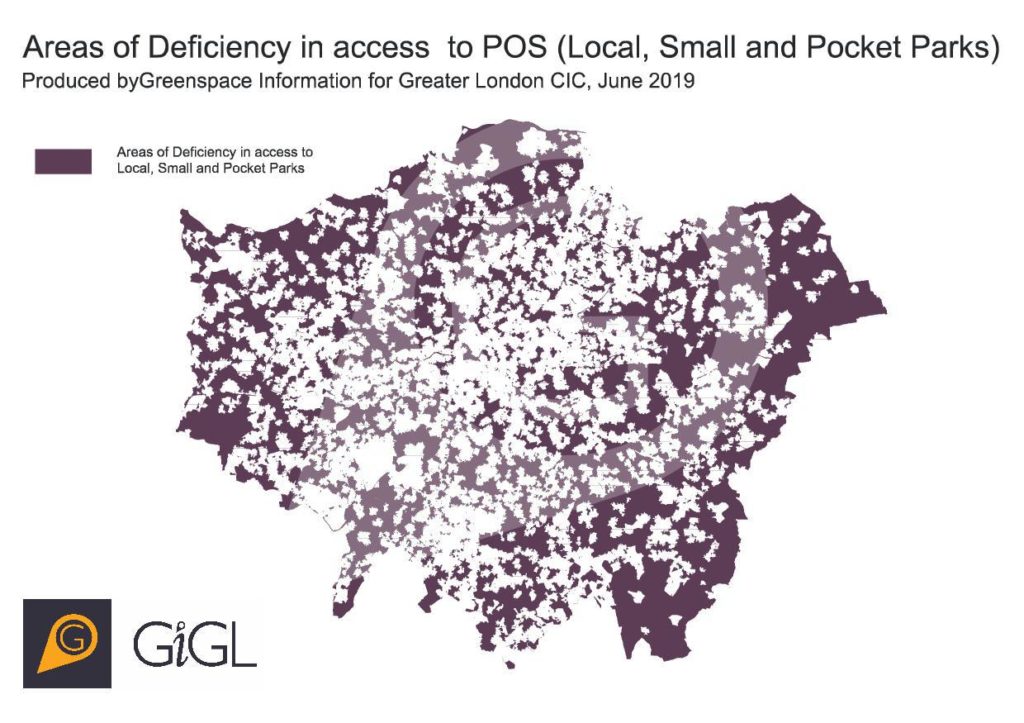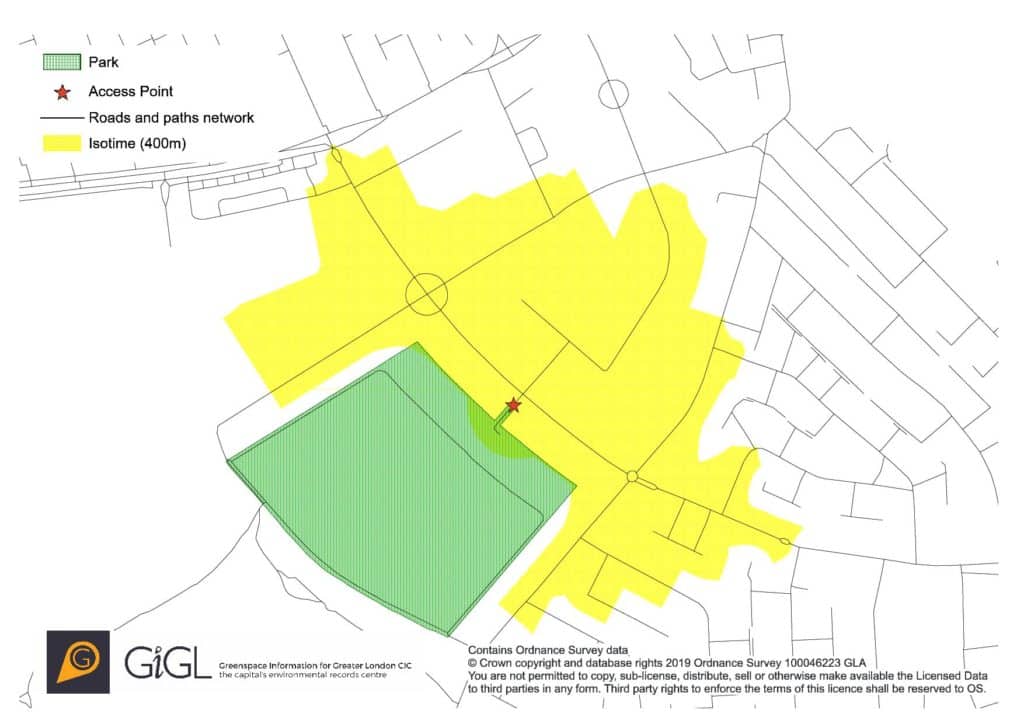Emma Knowles, GiGL Partnership Officer
What is AoD?
Areas of Deficiency (AoD) are areas outside of a specified walking distance from open spaces that meet particular criteria. GiGL have two AoD datasets:
- AoD to Nature are areas over 1km walking distances from Sites of importance for Nature Conservation (SINCs).
- AoD to Public Open Space are similar, but with different walking distances for different categories of Public Open Space (POS).
So what exactly are SINCs and POS?
SINCs are London’s Local Wildlife Sites: areas which are designated for protection for the benefit of wildlife. There are three grades of SINCs: Metropolitan, Borough and Local. SINCs are designated by Local Authorities in their (non-statutory) planning policies, and are selected with assistance from local ecological professionals. You may read more about the SINCs process here.
AoD to Nature is modelled only for Borough and Metropolitan grade SINCs. Sites which have national or international statutory wildlife conservation designations (e.g. Special Protection Areas) are also included in the model as Metropolitan grade SINCs.
Public Open Spaces are sites which meet the criteria given in Table 8.1 in the London Plan. There are seven different categories, based on the size of the sites and the facilities they offer. Of course, they must be publicly accessible. Some London boroughs identify Public Open Space in their planning strategies, in which case these are used for the AoD modelling, but where they do not, GiGL have inferred which sites are likely to qualify as POS based on the information available in our open space database; there is more information about the methodology for this on our Public Open Space Categories webpage.

Why do we measure AoD?
Areas of Deficiency mapping gives an indication of whether people living and working in a given area can easily visit Public Open Spaces or wildlife sites. It is often a more meaningful measure of people’s access to open space, or to nature, than simply calculating the total number of relevant sites (or their total land area), because it accounts for the distribution of sites within your area of interest and acknowledges the effect of sites in neighbouring areas.
For example: if the Public Open Space in a particular London borough is mostly at one end of it, then, even if the total area of POS in the borough is large, there will also be large areas at the other end where people are unlikely to benefit from the POS because it is too far away for them to walk to. In contrast, people living near the edges of a borough with a small area of POS may still be able to easily visit Public Open Spaces in neighbouring boroughs.
How is AoD used?
Areas of Deficiency mapping is used by Local Councils to assess open space provision in their boroughs. The London Plan, a policy document which sets out the development framework for London, states that Local Councils should reduce deficiency in access to open space and to nature; to achieve this, they need to know where the deficient areas are and understand their causes. AoD to both POS and SINCs can be reduced in different ways: by creating more sites or expanding their area; by improving the quality of open spaces so that they become relevant as Public Open Space or SINCs; or by improving access to existing sites by adding gates, removing access restrictions or improving local walking routes.
Students and researchers often use our AoD mapping in their projects: analysing it against other datasets to find out whether living in AoD correlates with factors such as health, crime rates or house prices.
With access to census data, AoD maps can be used to calculate statistics on the numbers of people living in AoD, which can provide further detail for policy making or research. AoD is a binary variable: you either are in an Area of Deficiency or you are not; but by calculating the % area of AoD in each region – for example wards, LSOAs or boroughs – we can generate statistics for comparison across London.
As with all GiGL datasets, the information is not limited to its original context and can potentially be used by our diverse assortment of partners and clients in a great variety of ways, including: campaigning, education, journalism, historical studies and artwork.
How is AoD measured?
AoD is sometimes mapped by simply drawing an “as the crow flies” buffer of the relevant walking distance around the boundaries of the SINCs/POS. GiGL have a more sophisticated method: we use software which calculates the walking distances from site access points along roads and paths, and adjusts the buffers accordingly. For this we use our dataset of site access points (some of which are known from site surveys and some of which are inferred from other data); and a digital map of the roads and paths network, which is made by Ordnance Survey.

The areas that are outside these walking distance zones (known as isotimes) are the AoD. The SINCs or Public Open Spaces themselves are also excluded from AoD – even ones which are not publicly accessible, since anyone who is in them must have gained access. Undeveloped Green Belt is also usually excluded from AoD to SINCs.
The 1km walking distances for (Metropolitan and Borough) SINCs is given in The Mayor’s Biodiversity Strategy (2002). It is based on research into what constitutes reasonable distance, and is used as standard. However, we can also model AoD using alternative systems, for example Natural England’s Accessible Natural Greenspace Standard (ANGSt) which has different walking distances depending on the quality and size of the site.
For many of the SINCs, Local Authorities have made individual recommendations about whether and how they should contribute to AoD alleviation; for example if a site is not in good condition, or if it is accessible, but only on public footpaths. Where only part of a site is both accessible to the public and good for wildlife, only that part is included in the AoD model; and if a SINC is designated solely on account of a particular inconspicuous species of specialist interest, it may not be included.
The walking distances for the POS are likewise based on research, and are set out in Policy 7.18 of the London Plan. For the Regional Parks, the highest grade, the walking distance is 8km – we are aware that this does not necessarily make sense as a walking distance, but in practice it still gives a sensible estimate of a maximum travel distance, even if it is actually cycling, driving or using public transport. Higher grades of POS count towards alleviating AoD to lower grades: so if you are not within the specified walking distance for a District Park, but you are within that distance from a Regional Park, then this does not count as AoD to District Parks because you can visit the Regional Park, just as easily, instead.
We update our AoD datasets on an ongoing basis. If you are interested in using our AoD mapping for your projects, please get in touch or check out our page on accessing GiGL Data.

P.S. Following further questions: Please note that it is possible to be right next to a relevant SINC or Public Open Space and still within AoD. This is because the sites don’t necessarily have access points on all sides – you might be on the other side of a wall from an excellent, publicly accessible site, and still have to walk around more than 1km’s (or whatever the walking distance is) worth of obstacles to get to a gate. This is particularly common for very big sites, and in areas with lots of railway lines.
It’s a pity that the poor “research” underlying the complex “Angst” criteria is still accepted as a scientific basis. We took all this into account when developing and revising the Areas of Deficiency system in London. Briefly, there are so many influences on access for so many different categories of users, and changing fashions. This means that the very limited research undertaken by the, then, English Nature was a very poor guide indeed. The complex Angst structure of distances to particular area categories of site is not research based, but little more than guesswork. We took quite a different approach, in seeking a simple indicator that could be used to incentivise positive changes to sites and their access, to measure changes across the map (AODs can increase as well as decrease so chages need to be measured across large map areas). There’s nothing magical about the one kilometre walking distance, it’s just of the right order of magnitude and of utility across the range of map areas one finds in London. Even now, the Angst guidelines do not cite the London system, one of the very few nationally that are still operational.